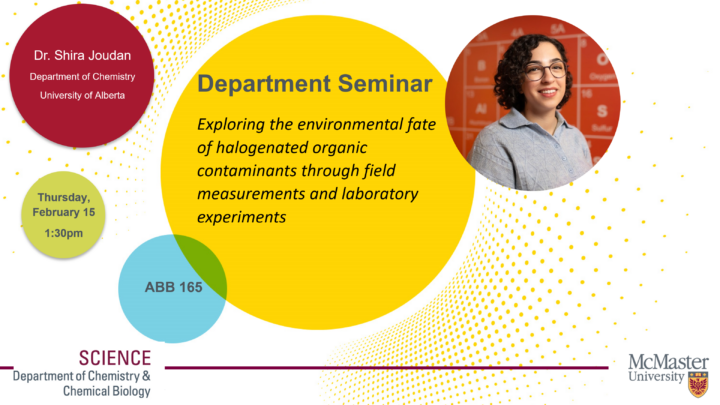Department Seminar: Dr. Shira Joudan
Feb 15, 2024
1:30PM to 2:20PM

Date/Time
Date(s) - 15/02/2024
1:30 pm - 2:20 pm
Title: Exploring the environmental fate of halogenated organic contaminants through field measurements and laboratory experiments
Date: Thursday February 15, 2024
Time: 1:30-2:20pm
Room: ABB 165
Host: Dr. Joseph Okeme
Abstract:
Many contaminants of highest concern in terms of their environmental persistence, bioaccumulation, and toxicity are halogenated organic contaminants. One key aspect of understanding the environmental fate of contaminants is investigating how chemical reactions transform the contaminants into other chemicals with different physicochemical properties that alter the risk profile, and modes of global transport. Understanding chemical reactions of anthropogenic contaminants must be approached from both controlled laboratory experiments and field observations. In this talk, I will discuss some of my postdoctoral research where we two complementary online mass spectrometry methods were used to measure halogenated organic acids, focusing on monochloro- and trifluoroacetic acid (MCAA, TFA) in the atmosphere. A new online ambient ion monitoring chromatography-ion chromatography-mass spectrometry system was developed and employed to measure a large suite of organic acids in the gas and particle phases of ambient Toronto air. Collaboration with Environment and Climate Change Canada used an acetate chemical ionization mass spectrometry for fast measurements of gas phase species. Together, these time-resolved measurements are the first online atmospheric measurements of both MCAA and TFA. In addition to providing quantitative measurements (low parts per trillion concentrations), the frequency of the measurements enables correlation with meteorological observations and shows clear photochemical trends for these chemicals, suggesting volatile, photoreactive precursors as key players in their formation. Now, at the University of Alberta, my research group is investigating the formation of TFA from aqueous photochemical reactions of aryl-CF3 compounds, a common structural motif in pesticides and pharmaceuticals present in the environment. We observe two competing mechanisms, defluorination of aryl-CF3 compounds, and ring-cleavage which leads to the formation of TFA. These two mechanisms are impacted by the pH of the solution and presence of substituents on the aromatic ring. Concentrations of TFA in the environment exceed the expected concentrations based on emissions of TFA and its known precursors, and so understanding the formation of TFA from aryl-CF3 helps to constrain the sources of TFA, which is currently a controversial chemical, and is considered the smallest per- and polyfluoroalkyl substance (PFAS).
Shira Joudan Bio
Shira Joudan is an assistant professor in the Department of Chemistry at the University of Alberta. Her new environmental analytical research group, which began in January 2023, investigates the environmental fate of organic contaminants, focusing on high priority chemicals that have been deemed persistent, toxic, or bioaccumulative, including per- and polyfluoroalkyl substances and tire-wear chemicals. Their work couples laboratory experiments to environmental measurements to understand how chemical reactions in the environment impact sources, transport, and exposure to contaminants. Prior to the UofA, Shira performed postdoctoral research at York University with Cora Young and earned her PhD from the University of Toronto working with Scott Mabury.
